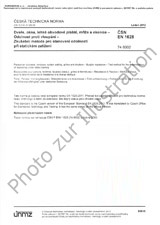Wir benötigen Ihre Einwilligung zur Verwendung der einzelnen Daten, damit Sie unter anderem Informationen zu Ihren Interessen einsehen können. Klicken Sie auf "OK", um Ihre Zustimmung zu erteilen.
ČSN ETSI EN 302977-V2.1.1 (876050)
Satellite Earth Stations and Systems (SES); Harmonised Standard for Vehicle-Mounted Earth Stations (VMES) operating in the 14/12 GHz frequency bands covering the essential requirements of article 3.2 of the Directive 2014/53/EU
Name übersetzen
NORM herausgegeben am 1.12.2016
Informationen über die Norm:
Bezeichnung normen: ČSN ETSI EN 302977-V2.1.1
Zeichen: 876050
Katalog-Nummer: 500802
Ausgabedatum normen: 1.12.2016
SKU: NS-668742
Zahl der Seiten: 56
Gewicht ca.: 168 g (0.37 Pfund)
Land: Tschechische technische Norm
Kategorie: Technische Normen ČSN
Kategorie - ähnliche Normen:
Die Annotation des Normtextes ČSN ETSI EN 302977-V2.1.1 (876050):
V2.1.1
The present document applies to Earth Stations located on board Vehicles, which have the following character-istics.
" The VMES may transmit and receive data when the vehicle is in motion and also when the vehicle is stationary.
" The VMES operates on wheeled or tracked vehicles and, therefore, may be subject to occasional dis-turbances and interruptions in the satellite link.
" The VMES is operating as part of a satellite network (e.g. star, mesh or point to point) used for the dis-tribution and/or exchange of information.
" The VMES is comprised of all the equipment, electrical and mechanical, from the antenna itself to the interface with other communications equipment on a vehicle (usually referred to as the terrestrial inter-face).
" The VMES transmits on single carrier in the frequency range 14,00 GHz to 14,50 GHz, which is a band allocated to the Fixed Satellite Services (FSS) (Earth to space) among other services. However, operation of the VMES is intended to be restricted to the lower half of the band in and near those countries that have allocated Fixed Service (FS) to the upper half. Local regulation may permit operation in the upper half of the band.
NOTE 1: For the purposes of the present specification, OFDM modulation is considered as a single carrier.
" The VMES receives in one or more frequencies within the range from 10,70 GHz to 12,75 GHz in bands allocated to the Fixed Satellite Services (FSS) (space to Earth) or the Broadcast Satellite Service (BSS) (space-to-Earth), depending on the ITU Region where the VMES is located.
" The VMES uses linear or circular polarization.
" The VMES is designed to operate through a geostationary satellite (or a cluster of co-located geosta-tionary satellites) that is at least 3° away from any other geostationary satellite operating in the same frequencies and over the same coverage area.
NOTE 2: Satellites may be spaced closer than 3°. In such cases, the satellite operator will inform the VMES client of the requirements of the system coordination agreements.
" The VMES transmits at elevations greater than or equal to 7 relative to the local horizon.
" The VMES is designed for unattended operation.
" The VMES is designed for both mobile and stationary operation. In the case of stationary operation, the VMES should not be accessible to the general public and operated safely.
" The VMES is controlled and monitored by an Antenna Control Facility (ACF). This function may be per-formed centrally (e.g. for a network of VMESs with a central hub) or it could be performed within the VMES for autonomous control. The ACF is outside the scope of the present document.
The present document applies to the VMES with its ancillary equipment and its various telecommunication ports, and when operated within the boundary limits of the operational environmental profile as declared by the applicant and when installed as required by the applicant´s declaration or in the user documentation.
The present document is intended to cover the provisions of Directive 2014/53/EU [9] (RE Directive) article 3.2, which states that ". radio equipment shall be so constructed that it both effectively uses and supports the effi-cient use of radio spectrumin order to avoid harmful interference".
NOTE 3: Operational requirements are defined by national administrations and by relevant ECC Decisions.
In addition to the present document, other ENs that specify technical requirements in respect of essential re-quirements under other parts of article 3 of the Directive 2014/53/EU [9] (RE Directive) may apply to equipment within the scope of the present document.
NOTE 4: A list of such ENs is included on the web site
Normansicht ČSN ETSI EN 302977-V2.1.1 (876050)
Empfehlungen:
Aktualisierung der technischen Normen
Wollen Sie sich sicher sein, dass Sie nur die gültigen technischen Normen verwenden?
Wir bieten Ihnen eine Lösung, die Ihnen eine Monatsübersicht über die Aktualität der von Ihnen angewandten Normen sicher stellt.
Brauchen Sie mehr Informationen? Sehen Sie sich diese Seite an.




 Cookies
Cookies
